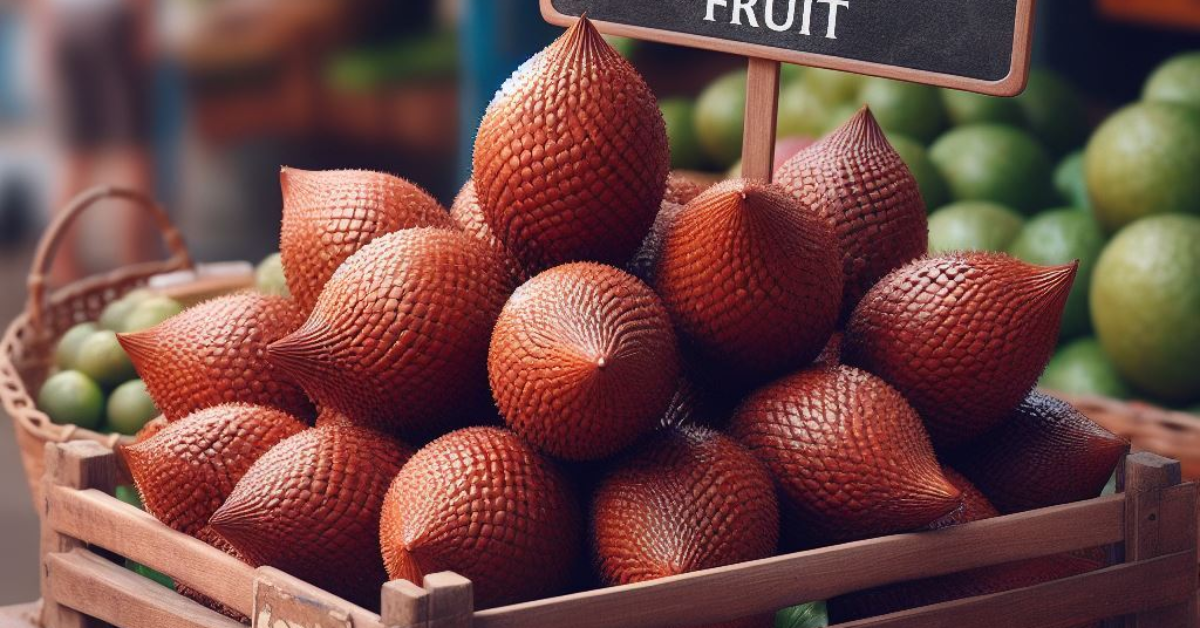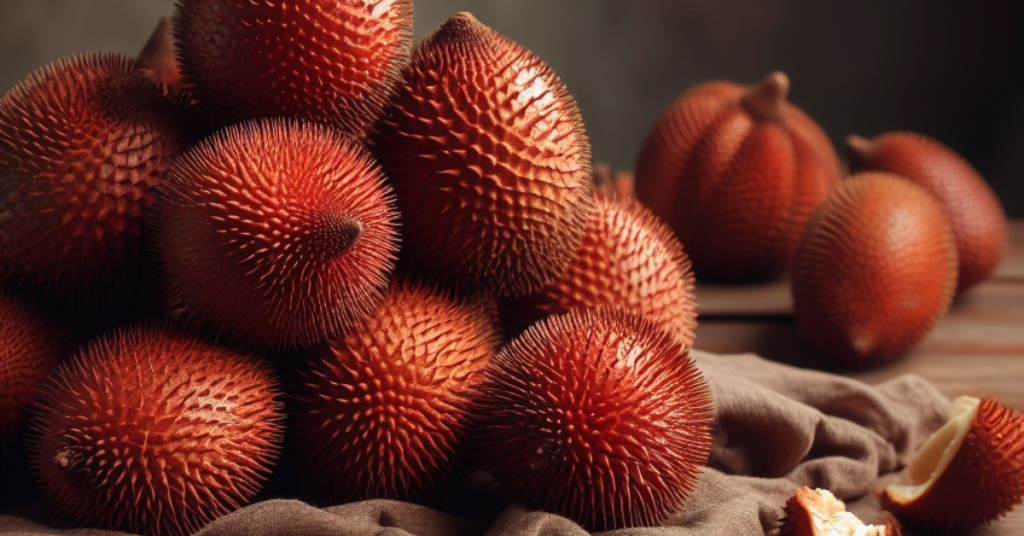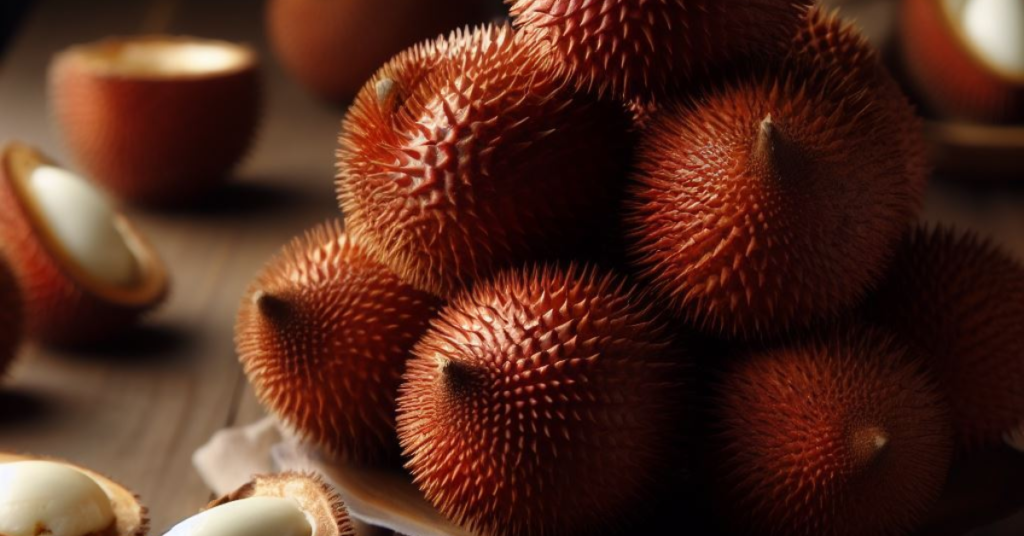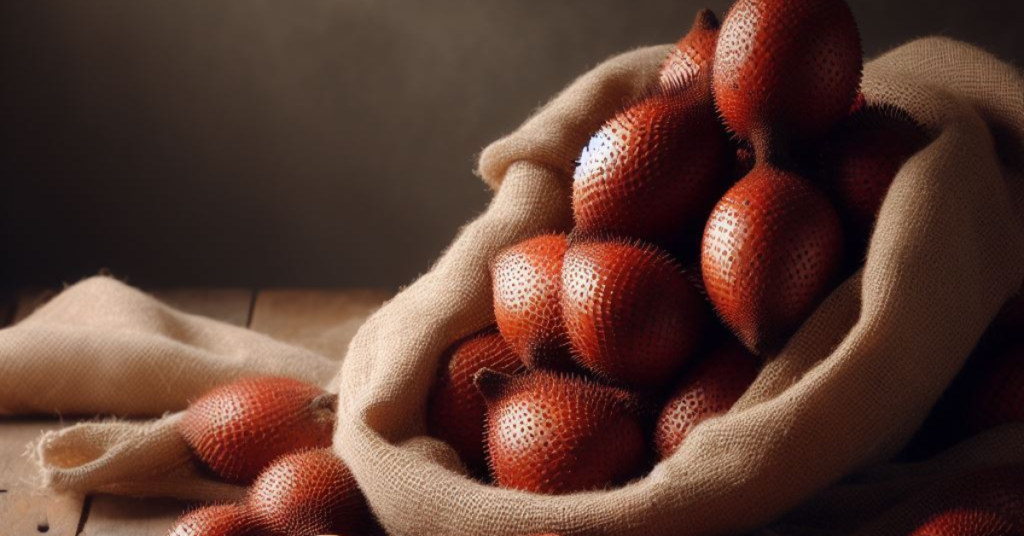Physical Address
304 North Cardinal St.
Dorchester Center, MA 02124
Physical Address
304 North Cardinal St.
Dorchester Center, MA 02124

Welcome to the world of tropical fruits! Prepare to be amazed by the deliciousness of salak, an exotic fruit with a one-of-a-kind flavor and texture.
Salak, also known as snake fruit, is a tropical delight hailing from Southeast Asia. This unique fruit possesses a distinctive appearance, with a red and scaly skin resembling that of a snake. However, don’t let its intimidating exterior fool you, as inside lies a delicious treat waiting to be discovered.
The pulp of the salak fruit offers a sweet and slightly acidic flavor, reminiscent of a delightful combination of pineapple, honey, and citrus fruits. But its appeal doesn’t stop at taste alone. Salak is also a nutritional powerhouse, packed with beneficial nutrients. It boasts a low calorie content while being rich in carbohydrates, fiber, vitamin C, potassium, and iron.
Aside from its delectable taste and impressive nutritional profile, salak also offers numerous health benefits. It is known for its antioxidant properties, which contribute to joint health, cellular regeneration, and body purification. Moreover, salak has become an integral part of the culinary culture in Malaysia and Indonesia, where it has been enjoyed for centuries.
Salak can be enjoyed in a variety of ways. Its fresh, juicy flesh makes it perfect for consumption as is, providing a refreshing snack. It can also be added to fruit salads, lending a unique and exotic twist to the mix. For those who prefer sipping their fruits, salak can be incorporated into smoothies and juices, giving them a tropical flair.
If you have a sweet tooth, salak can be transformed into jams or preserves, adding a burst of flavor to your breakfast spread. It can also be used as an ingredient in desserts and sauces, elevating their taste and introducing a touch of tropical goodness. Additionally, salak has a relatively long shelf life, making it suitable for long-distance transportation, allowing people around the world to enjoy its unique flavor.
As salak gains popularity globally, its demand continues to rise. The appreciation for exotic fruits, combined with salak’s delicious taste and enticing appearance, has made it a sought-after delicacy. So, the next time you’re looking to experience a truly tropical delight, sink your teeth into a juicy salak and savor the exotic flavors Southeast Asia has to offer.

With its scaly red skin resembling that of a snake, and a taste that’s a perfect blend of pineapple, honey, and citrus, salak is truly a feast for the senses. This exotic fruit, also known as snake fruit, is native to Southeast Asia and has gained popularity worldwide for its unique appearance and delicious flavor.
When you peel back the scaly skin of a salak, you’ll find three segments of juicy, creamy flesh. The texture is crisp and firm, similar to an apple, with a slightly acidic bite that adds a refreshing tang. The flavor profile of salak is complex and captivating, with its sweetness reminiscent of ripe pineapple, the delicate floral notes of honey, and a subtle hint of citrus zest.
Not only is salak a delight to the taste buds, but it also offers numerous health benefits. This tropical fruit is a nutritional powerhouse, packed with essential nutrients. Salak is low in calories and high in carbohydrates and fiber, making it a great choice for a healthy snack. It is also rich in vitamin C, potassium, and iron, which are vital for maintaining a strong immune system, healthy blood pressure, and optimal oxygen transport within the body.
Salak’s unique combination of flavors and textures lends itself to a variety of culinary uses. In tropical regions where it is traditionally consumed, salak is often eaten fresh or added to fruit salads, bringing a delightful crunch and burst of sweetness to the mix. Its tangy flavor also makes it a popular ingredient in smoothies and refreshing fruit juices.
For those with a sweet tooth, salak can be transformed into delectable desserts. Its firm flesh holds up well when cooked, making it suitable for baking or stewing in sweet syrups. You can use salak to create jams, preserves, and even sauces to accompany both sweet and savory dishes. The versatility of salak extends beyond the kitchen, as its unique appearance and flavor make it a stunning garnish for fruit platters or tropical-themed cocktails.
Whether enjoyed fresh or as part of a culinary creation, the popularity of salak continues to grow worldwide. Its exotic appeal, paired with its delicious taste and impressive nutritional profile, has made it a sought-after fruit for those seeking new and exciting flavors.
| Nutritional Content per 100g | Amount |
|---|---|
| Calories | 82 |
| Carbohydrates | 22g |
| Fiber | 2.6g |
| Vitamin C | 8.4mg |
| Potassium | 256mg |
| Iron | 0.6mg |
Salak is not only delicious but also packed with essential nutrients, making it a great choice for a healthy diet. This exotic tropical fruit from Southeast Asia is not only known for its unique appearance but also its impressive nutritional profile.
One of the standout features of salak is its low calorie content, which makes it an ideal snack for those watching their waistline. Additionally, salak is rich in carbohydrates, providing a quick and sustained source of energy. It is also high in fiber, aiding digestion and promoting a healthy gut.
Furthermore, salak is a great source of vitamins and minerals. It is particularly high in vitamin C, which boosts the immune system and supports collagen production for healthy skin and joints. Salak also contains significant amounts of potassium and iron, essential minerals that contribute to heart health and proper blood circulation.
With its antioxidant properties, salak provides numerous health benefits. These antioxidants help protect the body from harmful free radicals, promote joint health, and contribute to cellular regeneration. Salak also aids in the purification of the body, supporting detoxification processes.
In conclusion, salak is more than just an exotic fruit with a unique appearance. Its nutritional benefits make it an excellent addition to a balanced diet. Whether enjoyed fresh, added to salads and smoothies, or incorporated into various culinary creations, the versatility and health benefits of salak make it a beloved fruit worldwide. So why not give this nutritional powerhouse a try and experience the deliciousness and goodness of salak for yourself?
| Nutrient | Amount per 100g |
|---|---|
| Calories | 82 |
| Carbohydrates | 22g |
| Fiber | 2.6g |
| Vitamin C | 8.4mg |
| Potassium | 256mg |
| Iron | 2.6mg |

Salak trees thrive in tropical regions, and their fruit has been enjoyed for centuries in Malaysia and Indonesia. These countries are considered the primary cultivators of salak, with the fruit being an integral part of their culinary culture. Salak trees require specific conditions to flourish, including a warm climate with consistent temperatures ranging from 70 to 90 degrees Fahrenheit, high humidity levels, and well-drained soil.
The cultivation of salak typically begins by planting seeds or seedlings in the desired location. It takes approximately three years for the trees to start producing fruit, with full maturity achieved around eight to ten years. During this time, the trees require careful attention and regular maintenance, including proper watering, fertilization, and protection from pests and diseases.
The exact origin of salak is uncertain, but it is believed to have originated from the Indonesian archipelago. The fruit has been cultivated and consumed by the local communities for centuries. Salak trees can be found growing naturally in the wild, particularly in the tropical rainforests of Sumatra, Java, and Bali.
The popularity of salak has spread beyond Southeast Asia, and it is now grown in other tropical regions, including Thailand, the Philippines, and parts of Africa and South America. Its unique taste and nutritional benefits have contributed to its global demand, making it a sought-after fruit among adventurous food enthusiasts.
Salak is not only delicious but also offers numerous health benefits. It is rich in fiber, which aids in digestion and helps maintain a healthy gut. The fruit is packed with vitamins, particularly vitamin C, which strengthens the immune system and promotes collagen production for healthy skin. Salak also contains potassium, an essential mineral that regulates blood pressure and supports heart health.
Furthermore, salak is known for its antioxidant properties, thanks to the presence of phenolic compounds. These antioxidants help combat free radicals in the body, reducing the risk of chronic diseases and promoting overall well-being. Additionally, salak contains iron, which is vital for the production of red blood cells and the prevention of anemia.
With its unique flavor, nutritional benefits, and intriguing appearance, salak continues to captivate taste buds around the world. Whether enjoyed fresh, incorporated into various recipes, or used in traditional dishes, salak offers a delightful and nutritious addition to any culinary experience.
| Nutritional Content of Salak (per 100g) | Amount |
|---|---|
| Calories | 82 |
| Carbohydrates | 22 g |
| Fiber | 2.6 g |
| Protein | 0.6 g |
| Fat | 0.4 g |
| Vitamin C | 8.4 mg |
| Potassium | 256 mg |
| Iron | 2.6 mg |
Salak can be enjoyed in a variety of ways, from eating it fresh to incorporating it into salads, smoothies, and even desserts. Its unique appearance and flavor make it a popular choice for culinary experimentation, adding an exotic touch to any dish. Here are some creative ways to savor the delights of salak:
Remember to experiment with different combinations and cooking techniques to fully explore the versatility of salak. Its vibrant taste and texture will surely surprise and delight your taste buds.
“The combination of creamy coconut rice pudding and the burst of sweetness from salak creates a delightful dessert that is both rich and refreshing. Don’t miss the chance to savor this tropical treat!”
Ingredients:
| Quantity | Ingredient |
|---|---|
| 1 cup | Glutinous rice |
| 1 cup | Coconut milk |
| 1/2 cup | Water |
| 1/4 cup | Sugar |
| Pinch | Salt |
| 4-5 | Salak fruits, peeled and sliced |
Instructions:
Salak’s unique taste and versatility make it a standout ingredient in various cuisines. Whether you’re a fruit lover or an adventurous foodie, incorporating salak into your meals will add an exciting tropical twist.

If you’re considering growing your own salak tree, here are some essential tips to ensure its health and productivity.
1. Planting: Choose a well-draining soil with a slightly acidic pH level for optimal growth. Dig a hole deep enough to accommodate the root ball and gently place the sapling in it. To promote healthy root development, keep the top of the root ball level with the soil surface. Water thoroughly after planting.
2. Watering: Salak trees require regular watering, especially during the dry season. Keep the soil consistently moist but not waterlogged. Avoid overwatering, as it can lead to root rot. Mulching around the base of the tree helps retain moisture and suppresses weeds.
3. Pruning: Prune your salak tree regularly to maintain its shape and remove any dead or diseased branches. Pruning also helps promote better air circulation and sunlight penetration, which are crucial for fruit development. Remember to sanitize your pruning tools to prevent the spread of diseases.
4. Fertilizing: Apply a balanced fertilizer formulated for fruit trees every 2-3 months during the growing season. This will provide the necessary nutrients for healthy growth and abundant fruit production. Follow the instructions on the fertilizer packaging for the correct dosage based on the tree’s size.
Tip: Salak trees are dioecious, meaning they have separate male and female trees. To ensure fruit production, plant both male and female trees in close proximity.
| Aspect | Instructions |
|---|---|
| Planting | Choose well-draining soil with slightly acidic pH. Ensure proper planting depth. |
| Watering | Keep the soil consistently moist, but avoid overwatering. |
| Pruning | Regularly prune to maintain shape, remove dead or diseased branches. |
| Fertilizing | Apply balanced fruit tree fertilizer every 2-3 months during the growing season. |
To enjoy a bountiful harvest of salak fruit, proper care and maintenance are key. By following these tips, you can ensure the health and productivity of your salak tree. Happy cultivating!
Disclaimer: The information provided in this article is for educational purposes only and should not be considered as professional advice. Always consult with a horticulturist or agricultural expert for specific guidance based on your location and conditions.
As word spreads about the unique flavor and texture of salak, more and more people are seeking this tropical delicacy. With its intriguing appearance and delightful taste, salak has captured the attention of food enthusiasts around the globe. From vibrant fruit markets to trendy restaurants, salak is making its mark as a must-try fruit.
Salak’s popularity can be attributed to its distinct combination of flavors. The sweet and tangy pulp, reminiscent of pineapple, honey, and citrus fruit, creates a taste sensation that is both refreshing and satisfying. This exotic fruit has a loyal following among those who enjoy exploring new culinary experiences and appreciate the diversity of flavors.
In addition to its flavor, salak’s growing popularity can also be attributed to its versatility. This tantalizing fruit can be enjoyed in various ways, making it an excellent choice for both savory and sweet dishes. From adding it to fresh fruit salads and smoothies to incorporating it into jams, desserts, and sauces, salak brings a tropical twist to any recipe.
The rising demand for exotic fruits is another factor contributing to salak’s worldwide popularity. As consumers become more adventurous in their food choices, they are seeking out unique and unusual fruits that provide a new taste experience. Salak’s intriguing appearance, coupled with its delicious flavor, fulfills this desire for exotic flavors.
Moreover, as people become more health-conscious, they are seeking out fruits that offer both taste and nutritional benefits. Salak fits the bill perfectly, as it is not only delicious but also packed with essential nutrients. Its rich content of vitamins, minerals, and antioxidants makes it a valuable addition to a balanced diet.
| Key Points: | Salak’s Worldwide Popularity |
|---|---|
| Taste: | Unique combination of sweet and tangy flavors resembling pineapple, honey, and citrus fruit. |
| Versatility: | Can be used in a variety of dishes, from salads and smoothies to jams and desserts. |
| Increasing Demand: | Rising interest in exotic fruits and the desire for unique taste experiences. |
| Nutritional Benefits: | High in vitamins, minerals, fiber, and antioxidants, contributing to a well-rounded diet. |
As salak continues to gain recognition for its exceptional flavor and nutritional benefits, it is no surprise that its popularity is on the rise. Whether you’re a seasoned fruit enthusiast or someone looking to explore new tastes, don’t miss out on the opportunity to indulge in this tropical delight. Excite your taste buds with salak, and experience the joy of discovering a truly unique fruit.
Salak is a true gem among tropical fruits, offering a delightful taste, impressive health benefits, and a growing fan base around the world. This exotic fruit, also known as snake fruit, hails from Southeast Asia and boasts a unique red and scaly skin resembling that of a snake. But don’t be deceived by its appearance, because inside, you’ll discover a sweet and slightly acidic pulp that combines the flavors of pineapple, honey, and citrus fruit.
Not only is salak a delicious treat, but it also packs a nutritional punch. With low calorie content and high amounts of carbohydrates, fiber, vitamin C, potassium, and iron, salak is a powerhouse of essential nutrients. Its antioxidant properties contribute to joint health, cellular regeneration, and overall body purification.
Cultivated primarily in Malaysia and Indonesia, salak has been a staple in culinary culture for centuries in these regions. It thrives in tropical and subtropical climates and requires specific care and maintenance to ensure optimal growth. From enjoying it fresh to adding it to fruit salads, smoothies, juices, jams, preserves, desserts, and sauces, salak’s versatility knows no bounds.
Thanks to its relatively long shelf life and increasing demand for exotic fruits, salak has gained popularity worldwide. Whether you’re a fruit enthusiast or simply looking to expand your taste horizons, salak is a tropical treasure worth exploring. Its unique flavor, nutritional benefits, and growing presence in tropical regions make it a must-try for any adventurous palate.
Salak, also known as snake fruit, is an exotic tropical fruit from Southeast Asia.
Salak has a sweet and slightly acidic flavor, similar to a mix of pineapple, honey, and citrus fruit.
Yes, salak is highly nutritious, with low calorie content and high amounts of carbohydrates, fiber, vitamin C, potassium, and iron.
Salak is primarily cultivated in Malaysia and Indonesia.
Salak can be eaten fresh, added to fruit salads, used in smoothies and juices, made into jams or preserves, and even included in desserts and sauces.
Salak has a relatively long shelf life, making it suitable for long-distance transportation.
Salak is known for its antioxidant properties, promoting joint health, cellular regeneration, and purification of the body.
Salak grows best in tropical and subtropical climates and requires specific care and maintenance.
Salak has gained popularity worldwide due to its unique flavor and increasing demand for exotic fruits.

I’m Rachel Cooper, the brain and heart behind AboutWeirdFruits. If you’re here, you probably share the same insatiable curiosity for the fascinating world of exotic fruits that I do. From the spiky Durian to the unique Buddha’s Hand, I’ve been captivated by the diversity, flavors, and benefits these rare fruits bring into our lives.